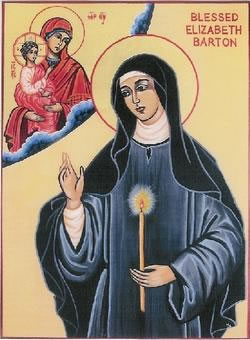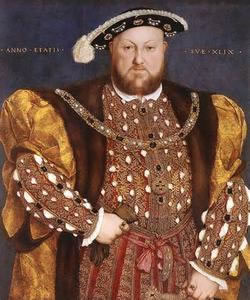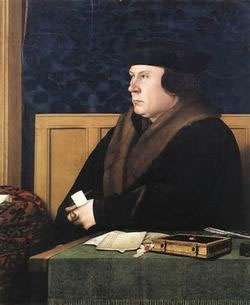When 'The Holy Maid of Kent' Came to Syon Park
Elizabeth Barton ignored warning 'not to speak of the affairs of princes'
|
I would imagine that followers of “Wolf Hall” and its shadowy hero Thomas Cromwell will probably have had enough of Sister Elizabeth Barton, the so called “Holy Maid of Kent” and arch-irritant to King Henry 8th but just in case you are suffering from Tudor cold turkey and need a fix…

The Story So Far … Elizabeth Barton was born in 1506 in Aldington, near Canterbury. In 1525, at the age of 18 and working as a servant for Thomas Cobb, she began suffering from hysterical fits and convulsions during which she claimed to experience heavenly visions and divine revelations. As well as foreseeing the death of a child in the Cobb household she began urging people to pray to the Virgin Mary and stay true to the Catholic Church. This was at a time when the King, Henry VIII, was in dispute with the Catholic Church. He was trying to persuade the Pope, Clement 7th, to annul his marriage to his first wife, Catherine of Aragon, and allow him to marry Anne Boleyn. The Pope was not pleased.
As Elizabeth Barton’s fame spread and probably encouraged by her clerical supporters, she became increasingly critical of Henry’s divorce plans. Aware of her popular reputation the King was prepared to put up with Elizabeth and even met her on a couple of occasions, but then her prophecies began to strike a little too close to home. In 1532 she predicted that if the King remarried he would die shortly after. (He didn’t. He actually lasted another 15 years.) She also said she had seen the place in Hell where he was destined to go! That was the last straw for Henry. In January 1533, while the King’s chief minister Thomas Cromwell prepared a case against her, the ‘Holy Maid of Kent’ came on retreat to Syon Monastery, in Syon Park where she was well received, particularly by the Confessor-General Richard Reynolds.

During her stay at Syon the ‘Holy Maid of Kent’ was visited by the lawyer and social philosopher, Sir Thomas More. Although a resolute Catholic, More had some serious doubts about Elizabeth and her ‘divine revelations’. When told a story about how an angel had visited the girl and given her a manuscript written in letters of gold Sir Thomas replied. ‘I believe the nun of Kent to be a virtuous woman, and that God is working great things by her; but stories like that you have told me are not part of our Credo, and before repeating them, one should be very sure about them.’

Thomas Cromwell
During their meeting in the little chapel at Syon Monastery Sir Thomas told Elizabeth not to dabble in political matters. “Do not speak of the affairs of princes’, he warned. It was too late. By then Henry had already broken from the authority of Rome, married Annie Boleyn and on June 1st 1533 seen her crowned as Queen of England. At the same time Thomas Cromwell’s agents were busily spreading rumours against Elizabeth Barton - about her alleged sexual relations with various priests, about her false prophecies, about her mental illness. Eventually in September 1533 she was arrested. Under torture authorised by the Archbishop of Canterbury, Thomas Cranmer, she confessed that her revelations and prophecies were false. In a letter dated 20 December 1533, Cranmer described his first meeting with Elizabeth Barton…
“When she was brought hither and laid before the Image of Our Lady, her face was wonderfully disfigured, her tongue was hanging and her eyes in a manner being plucked and laid upon her cheeks and so greatly disordered. Then there was a voice speaking within her belly, as if it had been in a tun, her lips not greatly moving while continuing by the space of three hours in a trance.”…
…All of which suggests that the Holy Maid of Kent’s heavenly revelations were coming not from divine intervention but from ventriloquism. Elizabeth Barton was convicted of heresy and treason by means of an Attainder, an act of Parliament authorising punishment without trial on the basis of her confession alone. On April 20th 1534 Elizabeth Barton and 5 of her co-conspirators were hanged at Tyburn for …”traterously attempting many notable actes intendyng therbye the disturbaunce of the pease and tranquyllytie of this Realm.
On the scaffold, Elizabeth said: ‘I am the cause not only of my own death, which I have richly deserved, but of the death of all those who are going to suffer with me. Alas! I was a poor wretch without learning, but the praises of the priests about me turned my brain, and I thought I might say anything that came into my head. Now I cry to God and implore the king’s pardon.’
The King wasn’t listening and Sister Elizabeth Barton ,a.k.a the ‘Holy Maid of Kent’, ‘The Nun of Kent’, ‘The Holy Maid of London’ and ‘The Mad Maid of Kent’ was hanged. Afterwards she was buried at Greyfriars Church in Newgate Street and her head put on a spike on London Bridge, the only woman in history to be accorded that dishonour.
On the very same day as her execution the City of London finally accepted that Henry had renounced the authority of Rome and had established himself as Supreme Head of the Church of England. The Reformation had started…
“On this day the most part of this City are sworn to the king and his legitimate issue by the Queen’s Grace now had and hereafter to come, and so shall all the realm over be sworn in like manner.”
Letter from John Husee to 1st Viscount Lisle, Uncle to Henry, 8th April 20, 1534
Article republished with kind permission from the St. Margarets Community Web Site
March 20, 2015